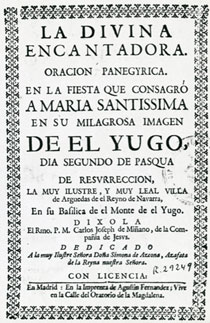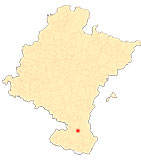Sanctuary of Nuestra Señora del Yugo
By Ricardo Fernández Gracia
Sacred oratory
The Virgin of the Yoke was the subject of important pieces of sacred oratory. As is well known, the rhetorical and theatrical resources in the sermons were in tune with the images. The latter were very frequent events and the preachers took great care in what they said in the pulpit, preparing ad hoc panegyrics, according to the audience, with the corresponding ornatus full of the prevailing rhetoric and always with the triple content of teaching, delighting and moving behaviour. The preacher was required to pray and study, as well as to excite fervour, displaying science, eloquence and wit. All this in order to achieve the three aforementioned aims of sacred oratory, which were none other than to movere, or to mark behaviour, not only by delighting and teaching, but also by moving the affections of hearts.
We know of sermons published in the 17th and 18th centuries. In 1709 a sermon to the Virgen del Yugo was published in Madrid, with degree scrollde La Divina encantadora, preached by the Navarrese Jesuit José Miñano, which we could call a true golden peak of the time. It is dedicated to Doña Simona de Azcona, who is pompously called "the queen's hostess" and who appears on the royal household's list of toilet attendants, together with Doña Beatriz de Valenzuela. Another sermon was published in Pamplona by the prolific Franciscan Friar Buenaventura de Arévalo in 1754 with degree scroll"La graciosísima Serrana. The city on the mountain above all the mountains. The universal protector, the most miraculous Image of Mary with the kind degree scrollof the Yoke". In 1795 the sermon to the Virgin of the Yugo dedicated to the lieutenant colonel of the Navarre Volunteers was also published.
-
MUNÁRRIZ, L., El santuario del Yugo, Pamplona, Imprenta y Librería de Joaquín Lorda, 1898.
-
GARCÍA GAÍNZA, M. C. and others, Catalog Monumental de Navarra. I. Merindad de Tudela, Pamplona, Government of Navarre-Archbishopric of Pamplona-University of Navarre, 1980.
-
FERNÁNDEZ-LADREDA, C., Imaginería medieval mariana, Pamplona, Government of Navarre, 1989.
-
FERNÁNDEZ GRACIA, R., "Un aspecto de la arquitectura barroca en Navarra: los camarines", conference proceedings del I congress General de Historia de Navarra. Príncipe de Viana (1988), appendix 11, pp. 149-158.
-
ECHEVERRÍA GOÑI, P. and FERNÁNDEZ GRACIA, R., "La arquitectura religiosa de los siglos XVI al XVIII en Navarra", Ibaiak eta Haranak. Guía del Patrimonio artístico y paisajístico. Navarra, vol. VIII, San Sebastián, Etor, 1991.
-
AZANZA LÓPEZ, J. J., Arquitectura Religiosa Barroca en Navarra, Pamplona, Government of Navarre, 1996.
-
FERNÁNDEZ GRACIA, R., The Baroque altarpiece in Navarre. Pamplona, Government of Navarre, 2003.












